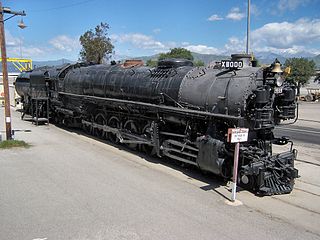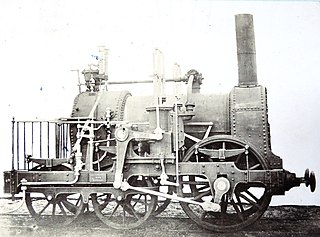Related Research Articles

A steam locomotive is a locomotive that provides the force to move itself and other vehicles by means of the expansion of steam. It is fuelled by burning combustible material to heat water in the locomotive's boiler to the point where it becomes gaseous and its volume increases 1,700 times. Functionally, it is a steam engine on wheels.

A tank locomotive or tank engine is a steam locomotive which carries its water in one or more on-board water tanks, instead of a more traditional tender. Most tank engines also have bunkers to hold fuel; in a tender-tank locomotive a tender holds some or all of the fuel, and may hold some water also.

Under the Whyte notation for the classification of steam locomotives, 0-4-0 represents one of the simplest possible types, that with two axles and four coupled wheels, all of which are driven. The wheels on the earliest four-coupled locomotives were connected by a single gear wheel, but from 1825 the wheels were usually connected with coupling rods to form a single driven set.

On a steam locomotive, a driving wheel is a powered wheel which is driven by the locomotive's pistons. On a conventional, non-articulated locomotive, the driving wheels are all coupled together with side rods ; normally one pair is directly driven by the main rod which is connected to the end of the piston rod; power is transmitted to the others through the side rods.

Under the Whyte notation for the classification of steam locomotives, 4-2-0 represents the wheel arrangement of four leading wheels on two axles, two powered driving wheels on one axle and no trailing wheels. This type of locomotive is often called a Jervis type, the name of the original designer.

Under the Whyte notation for the classification of steam locomotives, 4-2-2 represents the wheel arrangement of four leading wheels on two axles, two powered driving wheels on one axle, and two trailing wheels on one axle.

The Union Pacific Railroad 9000 Class was a class of 88 steam locomotives, built by ALCO for the Union Pacific between 1926 and 1930.

Under the Whyte notation for the classification of steam locomotives by wheel arrangement, 4-10-2 represents the arrangement of four leading wheels, ten powered and coupled driving wheels and two trailing wheels. In South Africa, where the wheel arrangement was first used, the type was known as a Reid Tenwheeler. In the United States of America it was known as a Southern Pacific on the Southern Pacific Railroad and as an Overland on the Union Pacific Railroad.

The Stephenson valve gear or Stephenson link or shifting link is a simple design of valve gear that was widely used throughout the world for various kinds of steam engines. It is named after Robert Stephenson but was invented by his employees.

Under the Whyte notation for the classification of steam locomotives by wheel arrangement, a 4-6-2+2-6-4 is a Garratt or Union Garratt articulated locomotive using a pair of 4-6-2 engine units back to back, with the boiler and cab suspended between them. The 4-6-2 wheel arrangement of each engine unit has four leading wheels on two axles, usually in a leading bogie, six powered and coupled driving wheels on three axles, and two trailing wheels on one axle, usually in a trailing truck.

Under the Whyte notation for the classification of steam locomotives, 2-6-0+0-6-2 represents the wheel arrangement of an articulated locomotive with two separate swivelling engine units, arranged back to back with the boiler and cab suspended between them. Each engine unit has two leading wheels in a leading truck, six powered and coupled driving wheels on three axles and no trailing wheels.

The Dundee and Newtyle Railway opened in 1831 and was the first railway in the north of Scotland. It was built to carry goods between Dundee and the fertile area known as Strathmore; this involved crossing the Sidlaw Hills, and was accomplished with three rope-worked inclined planes. Newtyle was simply a remote railhead, and the anticipated traffic volumes were not achieved, the inclines incurred heavy operating costs, and the railway never made money.
Under the Whyte notation for the classification of steam locomotives, 0-2-4 represents the wheel arrangement of no leading wheels, two powered driving wheels on one axle, and four trailing wheels on two axles.

Under the Whyte notation for the classification of steam locomotives by wheel arrangement, 2-6-2+2-6-2 is an articulated locomotive using a pair of 2-6-2 power units back to back, with the boiler and cab suspended between them. The 2-6-2 wheel arrangement has a single pair of leading wheels in a leading truck, followed by three coupled pairs of driving wheels and a pair of trailing wheels in a trailing truck.

London and North Western Railway (LNWR) 2-2-2 No. 3020 Cornwall is a preserved steam locomotive. She was built as a 4-2-2 at Crewe Works in 1847, but was extensively rebuilt and converted into her current form in 1858.

James Stirling was a Scottish engineer, and brother of Robert Stirling. He originally specialised railway engines and later in dock gates and weirs

The NZASM 32 Tonner 0-4-2RT of 1894 was a South African steam locomotive from the pre-Union era in Transvaal.

The Central South African Railways Rack 4-6-4RT of 1905 was a South African steam locomotive from the pre-Union era in Transvaal Colony.

J and C Carmichael was founded in 1810 at Ward Foundry, Session Street, Dundee, Scotland. The partners were James Carmichael (1776–1853) and his younger brother Charles Carmichael (1782–1843).

Earl of Airlie was an 1833 steam locomotive designed and built by J and C Carmichael for the 4ft 6in gauge Dundee and Newtyle Railway, with a 0-2-4 wheel arrangement and a tender. It was the first steam passenger locomotive in Scotland and the first locomotive in the United Kingdom to have a bogie.
References
- ↑ "FDCA - James Carmichael, Engineer". www.fdca.org.uk. Archived from the original on 5 December 2021. Retrieved 8 June 2021.
- ↑ Dundee Post Office Directory 1856
- ↑ "David Carmichael". The Engineer . V (79): 398. 10 May 1895.
- ↑ Marshall, John (1978). A Biographical Dictionary of Railway Engineers.